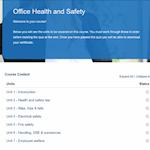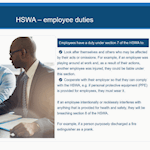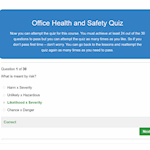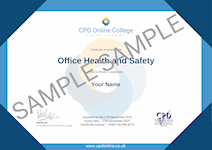Office Health and Safety CPD Course
Online CPD course covering health and safety in the office
CPD Online College
Summary
- Exam(s) / assessment(s) is included in price
Add to basket or enquire
Overview
Our Office Health and Safety course will help you gain a greater understanding on the importance of health and safety, as it prevents workers and others from being injured or being made ill while they are work. You will learn the three main reasons that employers should manage health and safety in the workplace and that it is there obligation to ensure health and safety is adhered to.
CPD
Course media
Description
Our Office Health and Safety course is suitable for anyone working in a office environment.
In our course you will look at good health and safety management vs. poor health and safety management and the implications that employees and the business could have if good health and safety management is not enforced.
You will learn that if a business has one or more employees, employers' liability insurance is legally required under the Employers' Liability (Compulsory Insurance) Act 1969.
You will also gain a greater understanding around the moral and financial reasons for managing health and safety and that ensuring the health, safety and welfare of employees is also a legal requirement under the health and safety law.
The European Union (EU) has had a major influence on health and safety legislation in the United Kingdom (UK).
As a previous member state, the UK has been required to adopt and introduce numerous directives and regulations, the legislation currently remains unchanged even though the UK has left the EU.
In our Office Health and Safety course you will acknowledge the statistics around slips, trips and falls which will highlight the seriousness to why health and safety should be in place.
You will learn that electrical hazards in the office can be prevented by maintainf equipment regularly.
Fixed electrical installation should be correctly selected, installed, used and maintained to prevent, fault, defectiveness or damages.
At the end of our Office Health and Safety course, you will learn that there can be multiple demands and pressures in work and that if too much a person may find that they cannot cope and therefor become stressed.
There is a legal requirement to provide suitable and sufficient welfare facilities under the Health and Safety at Work etc. Act 1974 and the Workplace (Health, Safety and Welfare) Regulations 1992.
If welfare facilities are not sufficient, it can result in physical and psychological illness. It can also cause low morale and low productivity if employees feel that the employer is not bothered about their welfare.
In order to complete the course, you must achieve 80% or more in the final multiple choice quiz.
You will earn 3 CPD points on completion of the course, this course will take around 3 hours to complete and the certificate will last for two years.
- Fully CPD registered
- Completed online with instant downloadable certificate
- Fully printed certificate posted next day
Unit covered.
- Unit 1 - Introduction -In this first unit of our Office Health and Safety course, you will be introduced to some examples of office activities. You will look at what is included in a typical office environment. You will look at the meanings of hazard, risk, accident and near miss. You will look at some examples relating to offices. You will explore the different categories of hazard. You will look at some examples of office hazards that are included in those categories and consider what a risk assessment is and will explore the five steps of risk assessment.
- Unit 2 - Health and safety law - In this unit, you will consider why health and safety is important. You will look at the moral, legal and financial reasons for managing health and safety. You will also learn about employers' liability insurance. You will explore the two main pieces of health and safety legislation as well as exploring the health and safety regulations. You will learn about the requirements for reporting deaths, injuries and diseases under the Reporting of Injuries, Diseases and Dangerous Occurrence Regulations (RIDDOR) 2013.
- Unit 3 - Slips, trips and falls - In this unit, you will be introduced to slips, trips and falls and will look at some definitions. You will look at some statistics that will highlight the seriousness of these hazards and will consider some of the injuries that can result from accidents. You will explore ways of preventing falls from height and will consider the hierarchy of control for working at height. Finally, you will look at ladders, stepladders and kick stools and will consider how to reduce the risk of falls when using this equipment.
- Unit 4 - Electrical safety - In this unit of our Office Health and Safety course, you will look at the electrical equipment that can be found in an office-based environment. You will learn about what electricity is and will look at some electrical hazards in the office. You will consider some of the risks and injuries that can result from these hazards as well as looking at some examples of checks, inspections and tests. You will consider how the risks associated with electricity can be reduced and controlled and look at protective devices and other safety measures. You will look at how employees can spot electrical hazards in the office and the actions they should take.
- Unit 5- Fire safety - In this unit, you will be introduced to the importance of fire safety in the office and look at the fire triangle and consider how it can be used in fire prevention and control. You will look at sources of heat, fuel and oxygen in an office and learn about some of the causes of fire. You will look at fire safety law and will look at some of the legislation relating to fire safety in the workplace. You will look at the steps to a fire risk assessment and consider what should be covered in a suitable and sufficient assessment. You will consider ways of preventing and controlling the risk of fires and look at fire preventive and protective measures in further detail.
- Unit 6- Manual handling, DSE and hazardous substances - In this unit, you will be introduced to manual handling in the office and the injuries that can occur. You will learn about the Manual Handling Operations Regulations 1992 and will look at employer and employee duties. You will explore good manual handling techniques for lifting and carrying and consider other ways of reducing the risk of associated injuries. You will look at display screen equipment (DSE) and workstations in the office and learn about the health conditions that can arise from the improper use of DSE and poor workstation set-up. As well as considering some precautions that can be used to reduce the risk of ill health from DSE and workstations.
- Unit 7 - Employee Welfare - In this last unit of our Office Health and Safety course, you will be introduced to work-related stress and consider some of the effects, causes, risk factors and signs of stress. You will also look at mental health in relation to stress and learn about some of the legislation relevant to work-related stress. You will look at what should be included in a stress risk assessment and explore the management of work-related stress and reducing the risks. You will consider the actions to take if stress or mental health problems are reported. You will look at the importance of a positive health and safety culture in the office. and learn about the importance of communication and consultation. You will look at the legal requirement to consult with employees.
Who is this course for?
Anyone working in an office environment.
Requirements
There are no requirements needed to take this course.
Career path
To enhance knowledge around health safety in the office.
Reviews
Currently there are no reviews for this course. Be the first to leave a review.
Legal information
This course is advertised on reed.co.uk by the Course Provider, whose terms and conditions apply. Purchases are made directly from the Course Provider, and as such, content and materials are supplied by the Course Provider directly. Reed is acting as agent and not reseller in relation to this course. Reed's only responsibility is to facilitate your payment for the course. It is your responsibility to review and agree to the Course Provider's terms and conditions and satisfy yourself as to the suitability of the course you intend to purchase. Reed will not have any responsibility for the content of the course and/or associated materials.







